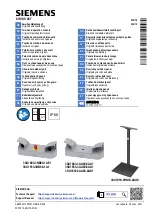
18
GL2400
User Guide
The STEREO Input Channel
Each
GL2400
stereo channel features a mono microphone preamp
as well as two stereo line inputs. These three sources can be used
independently or mixed together into the channel, so providing a
unique flexibility. For example, you could configure a conventional
mono microphone channel with the two ‘short return’ stereos routed
direct to LR for effects. Alternatively you could patch the mic stage as
an independent preamp for an ambience microphone feeding a
recording, or for a system calibration microphone, while the ST line
inputs mix two external stereo effects processor returns or sound
effects players via a single channel. This can be useful in saving
channels, letting you mix many inputs in a small space. Of course,
one stereo could feed the channel, the other route direct to LR. Two
stereo channels could be linked so that the mic preamps cross patch
to provide one stereo mic and one stereo line channel, with two ‘short
returns’ also available
… See ‘Operating Tips’ later in this guide.
MIC INPUT
Similar to the mono channel microphone preamplifier
without the line (pad) and polarity switches. Gain and 48V phantom
power switching are included. A rear panel MIC OUT breakpoint
socket is provided so that the mic stage can be used independently.
Plugging a jack into the MIC OUT socket breaks its signal path to the
stereo channel.
DUAL STEREO LINE INPUTS
Each stereo channel has two
stereo inputs which can be used separately, mixed together or split so
that one feeds the channel, the other routes direct to LR. ST1 and 2
feed channel 15 (23), ST3 and 4 feed channel 16 (24). The L input
signal is normalled through the R input socket so that a mono source
may be plugged in to feed both left and right sides of the stereo
channel. Each input has its own level control to adjust from fully off to
+16dB gain. Centre position is unity (0dB) gain.
Routing mode switch
Recessed to prevent accidental
operation. In the normal up position the ST signal mixes into the
associated stereo channel. When pressed the signal is routed direct
to the LR mix instead of the channel.
EQ
Similar to the mono channel, but the two peak/dip mid bands
are fixed at 250Hz and 2.5kHz centre frequencies.
AUX SENDS
These work as described for the mono channel, but
the L and R sides of the stereo signal sum together to feed each aux in
mono. This can be changed using an internal jumper so that L feeds
the odd numbered auxes and R feeds even. The auxes can be
switched pre or post-fader but are always sourced post-EQ.
BAL
Balances the level of the L signal against the R signal to
compensate for differences in the source, or to position the signal
within the stereo image.
MUTE
When pressed, all the channel pre and post-fade signals are
turned off except the MIC OUT and any stereo routed direct to LR.
PFL
Press PFL to display the summed L+R pre-fade channel signal
on the monitor meters and listen to it in the headphones and local
monitor without affecting the main outputs.
METER
As the mono channel, but the left and right signals are
summed to display in mono.
ROUTING
As the mono channel, but routes the left signal to L and
odd groups, right signal to R and even groups.
FADER
The stereo fader pr10dB maximum boost above
its normal unity gain 0dB position
PRE
AUX
AUX
4
3
AUX
AUX
2
1
O
O
+6
POST
O
O
+6
O
O
+6
O
O
+6
6
AUX
AUX
5
MUTE
+6
O
O
PRE
POST
O
O
+6
EQ IN
-15
LF
-15
LM
-15
HM
-15
+15
+15
+15
+15
HF
GAIN
20
60
50
40
30
+48V
LR
LR
MIC
ST4
STEREO
ST3
STEREO
CH16
CH16
12k
80Hz
2k5
250Hz
ODD
BAL
L
EVEN
R
=
6
-5
O
-10
-20
5
O
10
16
0
-5
O
-10
-20
5
O
10
16
0
















































